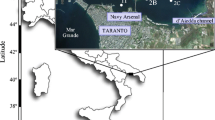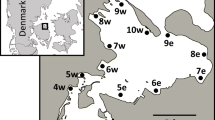Abstract
δ13C and δ15N values of two generalists primary consumers, a strict deposit-feeder polychaete (Arenicola marina), and a strict suspension-feeder bivalve (Crassostrea gigas), were investigated to typify the trophic functioning of two contrasted marine coastal ecosystems (eutrophic and mesotrophic, east and west Cotentin peninsula, respectively, English Channel, Normandy, France). On average, δ13C and δ15N values of lugworms mirrored those of sediment organic matter (SOM), whereas δ13C and δ15N of oysters mirrored those of suspended particulate organic matter (SPOM). δ13C values of the two species displayed significant differences on the west coast (mesotrophic) contrary to the east coast (eutrophic; significant interactions). δ15N values differed only between sites and not between species. Diet of A. marina relied exclusively on microphytobenthos (MPB) and detritus of macroalgae (ULV) on the mesotrophic coast, whereas diet of C. gigas relied mainly on SPOM. Conversely, on the eutrophic ecosystem (the east coast), both species displayed the same diet, which was a mixture of pelagic sources (SPOM), benthic sources (MPB and ULV) and to a lesser extent riverine particulate organic matter (rPOM). These results were explained by the intensity of benthic vs. pelagic couplings (i.e. benthic-pelagic and pelagic-benthic) which differed in the two ecosystems. Low trophic coupling occurred on the mesotrophic (west) coast, whereas benthic-pelagic (SOM resuspension) and pelagic-benthic (settling of SPOM such as phytoplankton blooms) couplings were typified on the eutrophic (east) coast. This higher particulate organic matter (POM) pelagic-benthic coupling on the east coast was probably enhanced by nutrient enrichment caused by eutrophication. Comparison of δ13C ratios of both the strict deposit-feeder (e.g. A. marina) and the strict suspension-feeder (e.g. C. gigas) was then proposed as a bio-indicator of the trophic status and of POM benthic vs. pelagic couplings of soft-bottom coastal ecosystems.



Similar content being viewed by others
References
Barillé, L., J. Prou, M. Heral, and D. Razet. 1997. Effects of high natural seston concentrations on the feeding, selection, and absorption of the oyster Crassostrea gigas (Thunberg). Journal of Experimental Marine Biology and Ecology 212: 149–172.
Bearhop, S., C.E. Adams, S. Waldron, R.A. Fuller, and H. MacLeod. 2004. Determining trophic niche width: a novel approach using stable isotope analysis. Journal of Animal Ecology 73: 1007–1012.
Borja, A., I. Muxika, and F. Franco. 2003. The application of a Marine Biotic Index to different impact sources affecting soft-bottom benthic communities along European coasts. Marine Pollution Bulletin 46: 835–845.
Bougrier, S., A.J.S. Hawkins, and M. Heral. 1997. Preingestive selection of different microalgal mixtures in Crassostrea gigas and Mytilus edulis, analysed by flow cytometry. Aquaculture 150: 123–134.
Ciutat, A., J. Widdows, and J.W. Readman. 2006. Influence of cockle Cerastoderma edule bioturbation and tidal-current cycles on resuspension of sediment and polycyclic aromatic hydrocarbons. Marine Ecology Progress Series 328: 51–64.
Cloern, J.E. 2001. Our evolving conceptual model of the coastal eutrophication problem. Marine Ecology Progress Series 210: 223–253.
Cloern, J.E., and A.D. Jassby. 2008. Complex seasonal patterns of primary producers at the land-sea interface. Ecology Letters 11: 1294–1303.
Dell’Anno, A., M. Mei, A. Pusceddu, and R. Danovaro. 2002. Assessing the trophic state and eutrophication of coastal marine systems: a new approach based on the biochemical composition of sediment organic matter. Marine Pollution Bulletin 44: 611–622.
Doi, H., M. Matsumasa, T. Toya, N. Satoh, C. Mizota, Y. Maki, and E. Kikuchi. 2005. Spatial shifts in food sources for macrozoobenthos in an estuarine ecosystem: carbon and nitrogen stable isotope analyses. Estuarine, Coastal and Shelf Science 64: 316–322.
Dubois, S., Blin, J.L., Bouchaud B., and S. Lefebvre. 2006. Isotope trophic-step fractionation in marine suspension-feeding species. The 5th international conference on applications of stable isotope techniques to ecological studies (ISOECOL), August 13-18th, Queens Univ. Belfast, Northern Ireland.
Dubois, S., J.L. Blin, B. Bouchaud, and S. Lefebvre. 2007. Isotope trophic step fractionation of suspension-feeding species: implications for food partitioning in coastal ecosystems. Journal Experimental Marine Biology and Ecology 351: 121–128.
Fabiano, M., and R. Danovaro. 1994. Composition of organic matter in sediments facing a river estuary (Tyrrhenian Sea): relationships with bacteria and microphytobenthic biomass. Hydrobiologia 277: 71–84.
Fertig, B., T.J.B. Carruthers, W.C. Dennison, A.B. Jones, F. Pantus, and B. Longstaff. 2009. Oyster and macroalgae bio-indicators detect elevated δ15N in Maryland’s coastal bays. Estuaries and Coasts 32: 773–786.
Fry, B. 1999. Using stable isotopes to monitor watershed influences on aquatic trophodynamics. Canadian Journal of Fisheries and Aquatic Sciences 56: 2167–2171.
Fry, B. 2006. Stable isotope ecology, 1st ed. New York: Springer.
Fry, B., and Y.C. Allen. 2003. Stable isotopes in zebra mussels as bioindicators of river-watershed linkages. River Research and Applications 19: 683–696.
Fukumori, K., M. Oi, H. Doi, D. Takahashi, N. Okuda, T.W. Miller, M. Kuwae, H. Miyasaka, M. Genkai-Kato, Y. Koizumi, K. Omori, and H. Takeoka. 2008. Bivalve tissue as a carbon and nitrogen isotope baseline indicator in coastal ecosystems. Estuarine, Coastal and Shelf Science 79: 45–50.
Grangeré, K., A. Ménesguen, S. Lefebvre, C. Bacher, and S. Pouvreau. 2009. Modelling the influence of environmental factors on the physiological status of the Pacific oyster Crassostrea gigas in an estuarine embayment; The Baie des Veys (France). Journal of Sea Research 62: 147–158.
Grangeré, K., S. Lefebvre, and J.L. Blin. 2012. Spatio-temporal dynamics of coastal ecosystem functioning as revealed by hydrobiological variables combined to stable isotope measurements of a benthic bioindicator. Estuarine, Coastal and Shelf Science 108: 109–118.
Gustafson, L., W. Showers, T. Kwak, J. Levine, and M. Stoskopf. 2007. Temporal and spatial variability in stable isotope compositions of a freshwater mussel: implications for biomonitoring and ecological studies. Oecologia 152: 140–150.
Haines, E.B., and C.L. Montague. 1979. Food sources of estuarine invertebrates analysed using 13C/12C ratios. Ecology 60(1): 56–58.
Hentschel, B. 1998. Intraspecific variations in δ13C indicate ontogenetic diet changes in deposit-feeding polychaetes. Ecology 79: 1357–1370.
Herman, P.M.J., J.J. Middelburg, J. Widdows, C.H. Lucas, and C.H.R. Heip. 2000. Stable isotopes as trophic tracers: combining field sampling and manipulative labelling of food resources for macrobenthos. Marine Ecology Progress Series 204: 79–92.
Jacobsen, V.H. 1967. The feeding of the lugworm Arenicola marina (L), quantitative studies. Ophelia 4: 91–109.
Kikuchi, E., and E. Wada. 1996. Carbon and nitrogen stable isotope ratios of deposit-feeding polychaetes in the Nanakita River Estuary, Japan. Hydrobiologia 321: 69–75.
Lefebvre, S., C. Harma, and J.L. Blin. 2009a. Trophic typology of coastal ecosystems based on delta C-13 and delta N-15 ratios in an opportunistic suspension feeder. Marine Ecology Progress Series 390: 27–37.
Lefebvre, S., J.C. Marìn Leal, S. Dubois, F. Orvain, J.L. Blin, M.P. Bataille, A. Ourry, and R. Galois. 2009b. Seasonal dynamics of trophic relationships among co-occurring suspension-feeders in two shellfish culture dominated ecosystems. Estuarine, Coastal and Shelf Science 82(3): 415–425.
Marìn Leal, J.C. 2007. Interactions trophiques entre l’huître creuse Crassostrea gigas et les suspensivores benthiques dans deux écosystèmes intertidaux en Basse-Normandie : utilisation des isotopes stables naturels (δ13C, δ15N) et des profils acides gras. Ph.D Thesis, France: Caen University. unpublished.
Marìn Leal, J.C., S. Dubois, F. Orvain, R. Galois, J.L. Blin, M. Ropert, M.P. Bataillé, A. Ourry, and S. Lefebvre. 2008. Stable isotopes (δ13C, δ15N) and modelling as tools to estimate the trophic ecology of cultivated oysters in two contrasting environments. Marine Biology 153: 673–688.
McCallister, S.L., J.E. Bauer, H.W. Ducklow, and E.A. Canuel. 2006. Sources of estuarine dissolved and particulate organic matter: a multi-tracer approach. Organic Geochemistry 37(4): 454.
McCutchan, J.H., W.M. Lewis, C. Kendhall, and C.C. McGrath. 2003. Variation in trophic shift for stable isotope ratios of carbon, nitrogen, and sulfur. Oikos 102: 378–390.
Nithart, M. 2000. Comparison of stable carbon and nitrogen isotope signatures of the polychaete Nereis diversicolor from different estuarine sites. Journal of the Marine Biological Association of the United Kingdom 80: 763–765.
Olive, P.J.W., J.K. Pinnegar, N.V.C. Polunin, G. Richards, and R. Welch. 2003. Isotope trophic-step fractionation: a dynamic equilibrium model. Journal of Animal Ecology 72(4): 608–617.
Parnell, A.C., R. Inger, S. Bearhop, and A.L. Jackson. 2010. Sources partitioning using stable isotopes: copying with too much variation. PloS One 5(3): e9672.
Paulet, Y.M., A. Lorrain, J. Richard, and S. Pouvreau. 2006. Experimental shift in diet δ13C: a potential tool for ecophysiological studies in marine bivalves. Organic Geochemistry 37: 1359–1370.
Philipps, D.L., S.D. Newsome, and J.W. Gregg. 2005. Combining sources in stable isotope mixing models: alternative methods. Oecologia 144: 520–527.
Piola, R.F., S.K. Moore, and I.M. Suthers. 2006. Carbon and nitrogen stable isotope analysis of three types of oyster tissue in an impacted estuary. Estuary Coastal and Shelf Science 66: 255–266.
Reise, K., M. Simon, and E. Herre. 2001. Density-dependent recruitment after winter disturbance on tidal flats by the lugworm Arenicola marina. Helgol Marine Resources 55: 161–165.
Riera, P., L.J. Stal, and J. Nieuwenhuize. 2000. Heavy delta N-15 in intertidal benthic algae and invertebrates in the Scheldt Estuary (The Netherlands): effect of river nitrogen inputs. Estuarine, Coastal and Shelf Science 51(3): 365–372.
Rombouts, I., G. Beaugrand, L.F. Artigas, J.-C. Dauvin, F. Gevaert, E. Goberville, D. Kopp, S. Lefebvre, C. Luczak, N. Spilmont, M. Travers-Trollet, M.C. Villanueva, and R.R. Kirby. 2013. Evaluating marine ecosystem health: case studies of indicators using direct observations and modeling methods. Ecological Indicators 24: 353–365.
Schaal, G., P. Riera, C. Leroux, and J. Grall. 2010. A seasonal stable isotope survey of the food web associated to a peri-urban rocky shore. Marine Biology 157: 283–294.
Turner, A., and E. Bishop. 2006. Processing of the chemical components of estuarine sediment by the lugworm, Arenicola marina. Estuarine, Coastal and Shelf Science 68: 86–92.
Ubertini, M., S. Lefebvre, A. Gangnery, K. Grangere, R. Le Gendre, R. Le Gendre, and F. Orvain. 2012. Spatial variability of benthic-pelagic coupling in an estuary ecosytem: consequences for microphytobenthos resuspension phenomonon. Plos One 7(8): e44155.
Vadeboncoeur, Y., E. Jeppesen, M.J. Vander Zanden, H.-H. Schierup, K. Christoffersen, and D.M. Lodge. 2003. From Greenland to green lakes: cultural eutrophication and the loss of benthic pathways in lakes. Limnology and Oceanography 48(4): 1408–1418.
Vollenweider, R.A., F. Giovanardi, G. Montanari, and A. Rinaldi. 1998. Characterisation of the trophic conditions of marine coastal waters with special reference to the NW Adriatic Sea: proposal for a trophic scale, turbidity and generalised water quality index. Environmetrics 9: 329–357.
Watson, G.J., L. Hannah, S.M. Gaudron, K.A. Betteley, and M.G. Bentley. 2008. Extension of the breeding season and its effects on fertilization and development in two species of lugworm (Arenicola marina and A. defodiens). Journal of Experimental Marine Biology and Ecology 354: 17–27.
Welschmeyer, N.A. 1994. Fluorometric analysis of chlorophyll a in the presence of chlorophyll b and pheopigments. Limnology and Oceanography 39: 1985–1992.
Acknowledgments
The authors are grateful to Lucile Menildrey and Clémentine Harma for helping in the collection of lugworms. We are grateful again to Lucile Menildrey but also to Jehanne Lepoittevin for technically processing the lugworm’s tissues and sediment core samples respectively prior to stable isotopes analyses. We are indebted to Marie-Paul Bataillé for her technical support in IRMS. This work was supported by the POMOYSTER program (2004–2007) financed by DIREN Basse-Normandie, Agence de l’eau Seine-Normandie and DRAM/IFOP. This manuscript has been professionally edited by Peter Magee and we thank him. Finally, we would like to thank the two anonymous reviewers and the associated editor Robert Christian for their fruitful comments on this manuscript.
Author information
Authors and Affiliations
Corresponding author
Additional information
Communicated by Wayne S. Gardner
Rights and permissions
About this article
Cite this article
Gaudron, S.M., Grangeré, K. & Lefebvre, S. The Comparison of δ13C Values of a Deposit- and a Suspension-Feeder Bio-Indicates Benthic vs. Pelagic Couplings and Trophic Status in Contrasted Coastal Ecosystems. Estuaries and Coasts 39, 731–741 (2016). https://doi.org/10.1007/s12237-015-0020-x
Received:
Revised:
Accepted:
Published:
Issue Date:
DOI: https://doi.org/10.1007/s12237-015-0020-x




